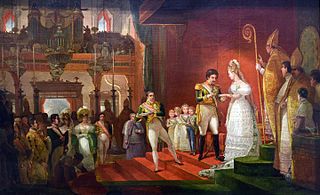Related Research Articles

"Cinderella", or "The Little Glass Slipper", is a folk tale with thousands of variants throughout the world. The protagonist is a young woman living in forsaken circumstances that are suddenly changed to remarkable fortune, with her ascension to the throne via marriage. The story of Rhodopis, recounted by the Greek geographer Strabo sometime between 7 BC and AD 23, about a Greek slave girl who marries the king of Egypt, is usually considered to be the earliest known variant of the Cinderella story.

A stepmother, stepmum or stepmom is a non-biological female parent married to one's preexisting parent. Children from her spouse's previous unions are known as her stepchildren. A stepmother-in-law is a stepmother of one's spouse.

The Slipper and the Rose: The Story of Cinderella is a 1976 British musical film retelling the classic fairy tale of Cinderella. The film was chosen as the Royal Command Performance motion picture selection for 1976.

The StoryTeller is a live-action/puppet television series that originally aired in 1987 and which was created and produced by Jim Henson.

Happily N'Ever After is a 2006 computer-animated family adventure comedy film directed by Paul J. Bolger, produced by John H. Williams, and written by Rob Moreland. It is inspired by fairy tales of the Brothers Grimm and Hans Christian Andersen and is loosely based on the 1999 animated German television series Simsala Grimm. The title is the opposite of a stock phrase, happily ever after; the name is contracted with an apostrophe between the N and the E. The film stars the voices of Sarah Michelle Gellar, Freddie Prinze, Jr., Andy Dick, Wallace Shawn, Patrick Warburton, George Carlin, and Sigourney Weaver. This film was one of Carlin's final works before he died.

"East of the Sun and West of the Moon" is a Norwegian fairy tale. It was included by Andrew Lang in The Blue Fairy Book (1890).

"Allerleirauh" is a fairy tale recorded by the Brothers Grimm. Since the second edition published in 1819, it has been recorded as Tale no. 65. Andrew Lang included it in The Green Fairy Book.

"Katie Woodencloak" or "Kari Woodengown" is a Norwegian fairy tale collected by Peter Christen Asbjørnsen and Jørgen Moe in Norske Folkeeventyr. Andrew Lang included it in The Red Fairy Book.

The false hero is a stock character in fairy tales, and sometimes also in ballads. The character appears near the end of a story in order to claim to be the hero or heroine and is usually of the same sex as the hero or heroine. The false hero presents some claim to the position. By testing, it is revealed that the claims are false, and the hero's true. The false hero is usually punished, and the true hero put in his place.

"The Three Little Men in the Wood" or "The Three Little Gnomes in the Forest" is a German fairy tale collected in 1812 by the Brothers Grimm in Grimm's Fairy Tales. Andrew Lang included it in The Red Fairy Book (1890) as "The Three Dwarfs," and a version of the tale appears in A Book of Dwarfs (1964) by Ruth Manning-Sanders.

Bushy Bride is a Norwegian fairy tale collected by Asbjørnsen and Moe. It is Aarne-Thompson type 403. It is included in Andrew Lang's Red Fairy Book.
"The White Bride and the Black One" is a German fairy tale collected by the Brothers Grimm, tale number 135. It is Aarne-Thompson type 403A. Other tales of this type include The Three Little Men in the Wood, Brother and Sister, Bushy Bride, and The Enchanted Wreath.
The Enchanted Wreath is a Scandinavian fairy tale, collected in Benjamin Thorpe in his Yule-Tide Stories: A Collection of Scandinavian and North German Popular Tales and Traditions. Andrew Lang adapted a variant of it for The Orange Fairy Book. It is Aarne-Thompson type 403B, the black and the white bride, and includes an episode of type 480, the kind and the unkind girls.

White-Bear-King-Valemon is a Norwegian fairy tale. The tale was published as No. 90 in Asbjørnsen and Moe's Norske Folke-Eventyr. Ny Samling (1871). George Webbe Dasent translated it for his Tales from the Fjeld.

"The Two Kings' Children" is a German fairy tale collected by the Brothers Grimm in Grimm's Fairy Tales, tale number 113.
Beauty and Pock Face is a Chinese fairy tale collected by Wolfram Eberhard in Chinese Fairy Tales and Folk Tales.
"The Three Fairies" is an Italian literary fairy tale written by Giambattista Basile in his 1634 work, the Pentamerone.

Ash is a young adult fantasy lesbian novel by Malinda Lo first published in 2009. It is a reworking of the Cinderella fairy tale that reimagines the title character, Ash, as a lesbian teenager. The novel centers around the familiar story of Cinderella, her father recently remarried, and lamenting the misery of her new life with stepsisters and a stepmother. The twist arrives when Ash falls in love with the King's respected huntress Kaisa, after she has made a commitment to dark fairy prince Sidhean.
"Grimm Job" is the tenth episode of the twelfth season of the animated comedy series Family Guy and the 220th episode overall. It originally aired on Fox in the United States and Canada on January 12, 2014, and was directed by Joe Vaux and written by Alec Sulkin.
Prince Wolf is a Danish fairy tale collected by Svend Grundtvig in his book Danske Folkeaeventyr. It is related to the international cycle of the Animal as Bridegroom or The Search for the Lost Husband. Tales with similar motifs and elements are found across Denmark and Scandinavia.
References
- ↑ Jacob and Wilheim Grimm, Household Tales, "The True Sweetheart"
- 1 2 D.L. Ashliman, "The Grimm Brothers' Children's and Household Tales (Grimms' Fairy Tales)"
- ↑ Heidi Anne Heiner, "Tales Similar to Cinderella"